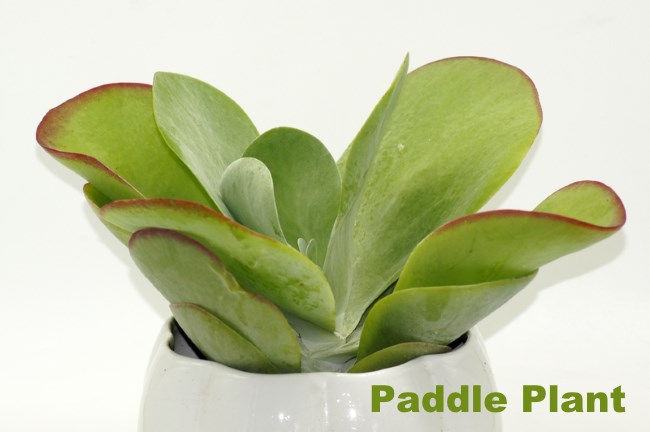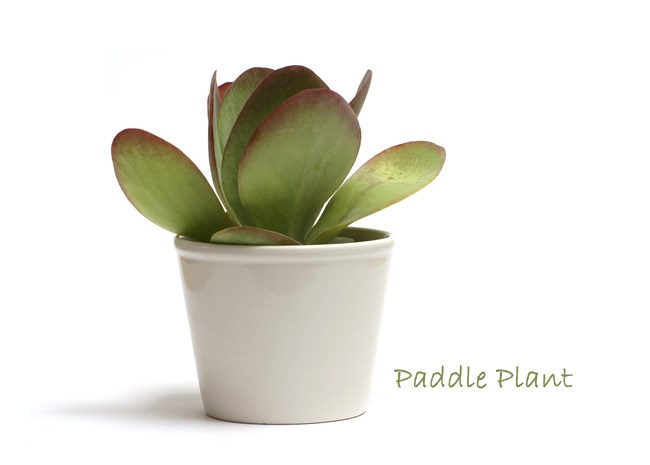Grow Paddle Plant Indoors
Paddle Plant is an eye-catching succulent you can grow indoors. If you're a fan of succulents, you'll want to add this sculptured silhouette to your collection.
Kalanchoe thyrsiflora also happens to be easy-care. Here you'll discover how much light and water it wants year-round, plus when to repot and more.
 Photo © Wirestock
Photo © WirestockGet to Know Paddle Plant as a Houseplant
Succulents take on many captivating shapes and forms, and this is one of the most fascinating. Paddle Plant is an unusual-looking succulent that grows in a rosette of flat, round leaves. It adds bold texture, color and form to a succulent dish garden, however this handsome houseplant is eye-catching on its own, too.
How big does it get? Kalanchoe thyrsiflora can reach a height up to 24 in (60 cm) tall.
The gray-green leaves grow to about 6 in (15 cm) across and will become tinged in red when exposed to sun.
Will it bloom? Mature plants may produce a spike of fragrant, yellow flowers in spring.
These South African succulents belong to the Crassulaceae family, an extremely varied group. You'll find Kalanchoe thyrsiflora for sale by many names: Paddle Plant, Desert Cabbage and Flapjack Plant are the most common.
Kalanchoe Thyrsiflora: 3 Keys to Success
Shed some light. Like most succulents, Paddle Plant grows best in bright light. It will even enjoy some direct sun. Move it outside for the summer, if you want. Just make the move a gradual one to avoid scorching its leaves. Be sure to bring it back indoors if the temperature drops below 50°F/10°C at night.
Keep it on the dry side. K. thyrsiflora is easy to grow in average room conditions, tolerating the dry air of heated homes well. The one thing it doesn't like is soggy soil, so I'd recommend potting it in a terra cotta pot with drainage holes and using a sandy medium, such as cactus potting mix for fast drainage.
Repot in spring when it becomes crowded -- but don't over-pot. Use a container that's only slightly larger. Why? Plants grow best when their roots are snug in the pot.
 Photo Credit: TommL/istockphoto
Photo Credit: TommL/istockphotoPaddle Plant Problems, Solutions and Answers
Drooping leaves may be caused by lack of sunlight, over-watering or extreme under-watering. Take care not to water the crown of the plant because it will rot; water the potting mix around the plant. See "Light" and "Water" tips below.
Leaves turning red? This is normal for Kalanchoe thyrsiflora when it's exposed to sunlight.
Something bugging your plant? Paddle Plants are typically pest-free, but the most common infestation for succulents is the mealybug. Watch for these white, cotton-like specks clustered at the base of the plant. Another possible pest is scale insects; they look like round, brown spots on the leaves. Isolate any infested plant to prevent them from moving on to your other houseplants and treat it immediately.
Wrinkled leaves? Your Paddle Plant is thirsty. Resist the temptation to over-water a succulent. Give your houseplant a little water, then water lightly again the next day, wait a few days, then water lightly again. After this, its leaves should be plumped up again.
Is Paddle Plant poisonous? Yes, according to the ASPCA, members of the Kalanchoe plant family are toxic to cats and dogs.
No blooms? Many succulents will not bloom until they are at least 3 years old. Some simply won't flower indoors because they don't get enough sunlight.
Paddle Plant Care Tips
Light: Set your Paddle Plant in your sunniest window. It thrives in bright light to full sun year-round. Give the pot a quarter turn every week or so to expose all sides to sunlight. Although this succulent will tolerate low light for a while, its leaves may wilt.
Water: Water thoroughly, then allow top 2 inches of soil to dry out between waterings. Don't allow soil to get soggy or the roots may rot. Avoid getting the leaves of Paddle Plant wet to prevent rot; water the potting mix or water from the bottom. Remember to always use room-temperature water when watering your houseplants because cold water is a shock to them.
Humidity: Average room (around 40% relative humidity).
Temperature: Average room temperatures 65-80°F/18-26°C. If you move Paddle Plant outdoors -- don't worry, it can take the heat. Just bring it back inside when temps drop -- it will tolerate a minimum of 50°F/10°C. Kalanchoe won't tolerate any frost, which will damage this succulent.
Soil: Cactus potting mix. Or mix 2 parts good-quality potting mix with 1 part horticultural sand.
Fertilizer: Feed quarterly with a cactus/succulent fertilizer.
Propagation: Take leaf cuttings in spring or summer and pot in moist cactus potting mix. It's much easier to propagate from seed; Paddle Plant seeds are easy to find online. It's a good idea to use a heat mat; succulent cuttings and seeds root fastest by maintaining an even 70°F/21°C.


